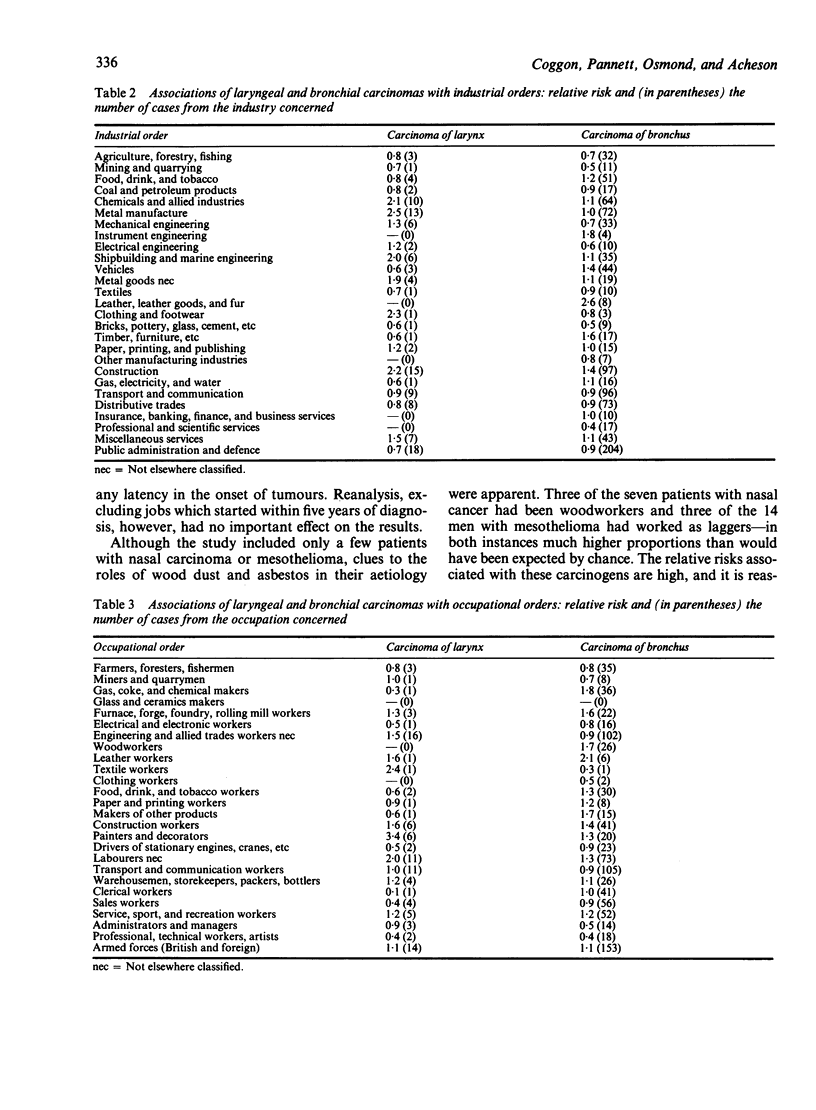Abstract
In a search for clues to previously industrial carcinogens the occupational and smoking histories of young and middle aged men with different types of cancer were compared. The study population comprised men aged 18-54 and resident in the counties of Cleveland, Humberside, and Cheshire (including the Wirral). From hospital and cancer registration records 2942 members of the study population in whom cancers were diagnosed during the period 1975-80 were identified retrospectively. The occupational and smoking histories of these patients were sought by a postal questionnaire addressed either to the patients themselves or, if they had died, to their next of kin. The overall response rate to the questionnaire was 52.1%. Additionally, limited occupational information was obtained for 89% of cases from their hospital notes. Analysis of these data suggests that no serious bias arose as a consequence of the incomplete response to the questionnaire. This paper concentrates on the results for cancers of the respiratory tract and mesothelioma. Mesothelioma was found to cluster in laggers, electricians, and shipyard workers, and nasal carcinoma in woodworkers. Carcinomas of the larynx and of the bronchus were examined by formal statistical techniques, each being compared with a control group made up of all other cancers combined. Several interesting occupational and industrial associations were shown, in particular, an excess of bronchial carcinoma in the leather industry (RR = 2.6, CI 1.2-6.0), in building labourers (RR = 1.7, CI 1.0-2.9) and other construction workers (RR = 1.8, CI 1.0-3.0), in bakers and pastry cooks (RR = 3.6, CI 1.3-10.4). and in cooks (RR = 2.5, CI 1.2-5.1). In addition, a small cluster of lung tumours was observed in men who had worked as dental mechanics.
Full text
PDF






Selected References
These references are in PubMed. This may not be the complete list of references from this article.
- BIDSTRUP P. L., CASE R. A. Carcinoma of the lung in workmen in the bichromates-producing industry in Great Britain. Br J Ind Med. 1956 Oct;13(4):260–264. doi: 10.1136/oem.13.4.260. [DOI] [PMC free article] [PubMed] [Google Scholar]
- Coggon D., Pippard E. C., Acheson E. D. Accuracy of occupational histories obtained from wives. Br J Ind Med. 1985 Aug;42(8):563–564. doi: 10.1136/oem.42.8.563. [DOI] [PMC free article] [PubMed] [Google Scholar]
- Doll R. Part III: 7th Walter Hubert lecture. Pott and the prospects for prevention. Br J Cancer. 1975 Aug;32(2):263–272. doi: 10.1038/bjc.1975.212. [DOI] [PMC free article] [PubMed] [Google Scholar]
- Dubrow R., Wegman D. H. Setting priorities for occupational cancer research and control: synthesis of the results of occupational disease surveillance studies. J Natl Cancer Inst. 1983 Dec;71(6):1123–1142. [PubMed] [Google Scholar]
- Menck H. R., Henderson B. E. Occupational differences in rates of lung cancer. J Occup Med. 1976 Dec;18(12):797–801. doi: 10.1097/00043764-197612000-00005. [DOI] [PubMed] [Google Scholar]
- Pippard E. C., Acheson E. D., Winter P. D. Mortality of tanners. Br J Ind Med. 1985 Apr;42(4):285–287. doi: 10.1136/oem.42.4.285. [DOI] [PMC free article] [PubMed] [Google Scholar]
- Weiss W., Boucot K. R. The respiratory effects of chloromethyl methyl ether. JAMA. 1975 Dec 15;234(11):1139–1142. [PubMed] [Google Scholar]


